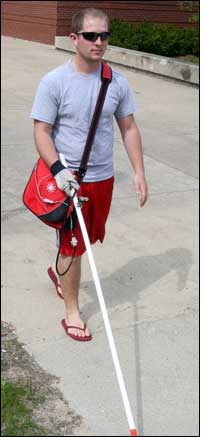A group of undergraduate engineering students at Central Michigan University have recently completed work on a prototype system designed to help guide blind people, and to help them avoid obstacles in their paths. The system employs RFID and ultrasonic technology incorporated into a cane that its developers hope will eventually result in a commercial product.
When devising technology for aiding the blind, says Kumar Yelamarthi, an assistant professor of electrical engineering at Central Michigan University, the two major design criteria are to enhance a user’s safety, and to provide a means for that individual to orient himself to his surroundings. To achieve these goals, an ultrasonic sensor for detecting objects in a user’s path is mounted on the cane, near the handle. For navigation, an EPC Gen 2 UHF RFID reader and antenna, carried in a messenger bag, detects RFID tags embedded in the sidewalk.
The messenger bag also houses a microcontroller that functions as the system’s brain, connecting the RFID interrogator, the ultrasonic sensor, a keypad (used to program a walking route) and the RFID and ultrasonic sensors that guide the user or alert him to obstructions. The ultrasonic sensor on the cane effectively extends the cane’s reach to roughly 8 feet, Yelamarthi says.
The RFID tags, embedded in the ground, serve as markers, enabling the system to determine a user’s location. Thus far, Yelamarthi says, the system has been tested in a limited manner, with RFID tags placed throughout a confined area. Each volunteer tester used the keypad to enter a predetermined path into the microcontroller, strapped the messenger bag over his shoulder, picked up the cane and set off. As the tester moved through the area, the reader would detect any tags within 3 to 4 feet, transmitting each tag’s ID number to the microcontroller. Based on the tag ID and the pre-set destination, the microcontroller provided a direction—either left or right—that was then conveyed to the user through an audio speaker mounted on the strap.
Whenever the volunteer approached an object in the cane’s path, the ultrasonic sensor detected this item and the microcontroller would, in response, alert the volunteer to the obstruction via the speaker, along with directions for how to get past that object.
To aid those who are both blind and deaf, the students also created a glove wired to the microcontroller in the bag. The system triggers the glove to vibrate in a pattern that tells a user he is coming upon an obstruction, or that directs that person to make a left or right turn.
Now, Yelamarthi says, a new group of undergraduate students are utilizing the feedback from the volunteer testers as they bring the Smart Cane project to the next level. In phase two of the design process, he adds, students will make a significant change. A self-propelled robot will take the place of the messenger bag, and rather than mounting the ultrasonic sensor on the cane, this sensor, as well as an RFID interrogator, will be built into the robot, which will roll along the sidewalk ahead of the user like a mechanical Seeing Eye dog. The user will hold some type of tether connecting him to the robot, though design specifications are still under development.
What’s more, Yelamarthi says, there will be an option for a glove (also linked to the tether) that will work in the same manner as that utilized in the phase-one device. This, he notes, should solve an important design flaw inherent in the initial Smart Cane, because it will allow the system to determine not just that an object is in its path, but also whether that object is moving. “The angle at which you hold the cane is important,” he explains, because it provides a reference point from which the system can determine whether an object is moving, and in which direction it is headed. “But each blind person holds the cane at slightly different angles, so to be able to determine movement of objects, we will put the sensor inside the robot.” This, he says, will provide a fixed reference point for the sensors.
Hoping to extend the project beyond this phase-two design—and, eventually, into a commercial product that will provide a new form of aid and navigation for not just blind users, but also those with a range of disabilities—Yelamarthi has applied for a three-year grant from the National Science Foundation. If the grant is awarded, the research project will be expanded to include electrical and mechanical engineers, as well as industrial-design students. The researchers will interview a number of disabled students and develop ways in which sensors and robotic aids could improve their on-campus mobility.
“My long-term—and, maybe, pie-in-the-sky—vision,” Yelamarthi says, “is that retailers will offer blind or disabled consumers a way to download directions onto a device” that they can then use to navigate through a store, using RFID tags and other sensor systems.
That’s something that the Michigan Commission for the Blind would like to happen, as well. According to Yelamarthi, the group has expressed interest in working with him and his students to further develop the Smart Cane project.
In Italy last year, the European Commission’s Joint Research Center (JRC), in collaboration with the RFID Lab at the Sapienza University of Rome, tested a similar solution, known as SEASONET (Secure and Safe Mobility Network). With the SEASONET system, an RFID reader antenna built into a cane’s tip captures the ID numbers of 125 kHz passive tags buried in walkways, and forwards them to a user’s PDA via a Bluetooth transmitter. The PDA, in turn, runs a software application that determines that individual’s location based on the tag ID, and generates directions transmitted to a wireless earpiece (see Tags Lead the Way for Blind in EU-Funded Pilot).


